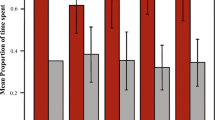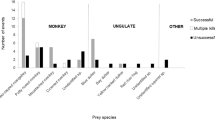Abstract
Robbing and bartering (RB) is a behavioral practice anecdotally reported in free-ranging commensal macaques. It usually occurs in two steps: after taking inedible objects (e.g., glasses) from humans, the macaques appear to use them as tokens, returning them to humans in exchange for food. While extensively studied in captivity, our research is the first to investigate the object/food exchange between humans and primates in a natural setting. During a 4-month study in 2010, we used both focal and event sampling to record 201 RB events in a population of long-tailed macaques (Macaca fascicularis), including four neighboring groups ranging freely around Uluwatu Temple, Bali (Indonesia). In each group, we documented the RB frequency, prevalence and outcome, and tested the underpinning anthropogenic and demographic determinants. In line with the environmental opportunity hypothesis, we found a positive qualitative relation at the group level between time spent in tourist zones and RB frequency or prevalence. For two of the four groups, RB events were significantly more frequent when humans were more present in the environment. We also found qualitative partial support for the male-biased sex ratio hypothesis [i.e., RB was more frequent and prevalent in groups with higher ratios of (sub)adult males], whereas the group density hypothesis was not supported. This preliminary study showed that RB is a spontaneous, customary (in some groups), and enduring population-specific practice characterized by intergroup variation in Balinese macaques. As such, RB is a candidate for a new behavioral tradition in this species.




Similar content being viewed by others
References
Addessi E, Crescimbene L, Visalberghi E (2007) Do capuchin monkeys use tokens as symbols? Proc R Soc Lond B 274:2579–2585
Addessi E, Mancini A, Crescimbene L, Visalberghi E (2011) How social context, token value, and time course affect token exchange in capuchin monkeys (Cebus apella). Int J Primatol 32:83–98
Agresti A (2007) Introduction to categorical data analysis. Wiley, New Jersey
Altmann J (1974) Observational study of behavior: sampling methods. Behaviour 49:227–267
Asquith PJ (1989) Provisioning and the study of free-ranging primates: history, effects, and prospects. Am J Phys Anthropol 32:129–158
Benjamini Y, Hochberg Y (1995) Controlling the false discovery rate: a practical and powerful approach to multiple testing. J R Stat Soc 57:289–300
Bevacqua S, Cerasti E, Falcone R, Cervelloni M, Brunamonti E, Ferraina S, Genovesio A (2013) Macaque monkeys can learn token values from human models through vicarious reward. PLoS One 8:e59961. doi:10.1371/journal.pone.0059961
Boesch C (2007) What makes us human (Homo sapiens)? The challenge of cross-species comparison. J Comp Psychol 121:227–240
Brosnan SF, de Waal FBM (2004) A concept of value during experimental exchange in brown capuchin monkeys, Cebus apella. Folia Primatol 75:317–330
Brotcorne F, Leca J-B, Gunst N, Wandia IN, Fuentes A, Huynen M-C (2015) Monkey business: inter-group differences in the object/food bartering practice in Balinese macaques (M. fascicularis) at the Uluwatu Temple, Indonesia. Folia Primatol 86:251
Brotcorne F (2014) Behavioral ecology of commensal long-tailed macaque (Macaca fascicularis) populations in Bali, Indonesia: impact of anthropic factors (PhD thesis), University of Liège
Chauhan A, Pirta RS (2010) Agonistic interactions between humans and two species of monkeys (Rhesus monkey Macaca mulatta and Hanuman langur Semnopithecus entellus) in Shimla, Himachal Pradesh. J Psychol 1:9–14
Coussi-Korbel S, Fragaszy DM (1995) On the relation between social dynamics and social learning. Anim Behav 50:1441–1453
Ditchkoff S, Saalfeld S, Gibson C (2006) Animal behavior in urban ecosystems: modifications due to human-induced stress. Urban Ecosyst 9:5–12
Dufour V, Pelé M, Neumann M, Thierry B, Call J (2009) Calculated reciprocity after all: computation behind token transfers in orang-utans. Biol Lett 5:172–175
Fooden J (1995) Systematic review of southeast Asian longtail macaques, Macaca fascicularis, [Raffles, (1821)]. Fieldiana Zool 81:1–206
Fox EA, van Schaik CP, Sitompul A, Wright DN (2004) Intra-and interpopulational differences in orangutan (Pongo pygmaeus) activity and diet: implications for the invention of tool use. Am J Phys Anthropol 125:162–174
Fuentes A (2010) Naturalcultural encounters in Bali: monkeys, temples, tourists and ethnoprimatology. Cult Anthropol 25:600–624
Fuentes A, Gamerl S (2005) Disproportionate participation by age/sex classes in aggressive interactions between long-tailed macaques (Macaca fascicularis) and human tourists at Padangtegal Monkey Forest, Bali, Indonesia. Am J Primatol 66:197–204
Gumert MD, Fuentes A, Jones-Engel L (2011) Monkeys on the edge. Ecology and management of long-tailed macaques and their interface with humans. Cambridge University Press, Cambridge
Hare B, Wobber V, Wrangham R (2012) The self-domestication hypothesis: evolution of bonobo psychology is due to selection against aggression. Anim Behav 83:573–585
Hoppitt W, Laland KN (2011) Detecting social learning using networks: a users guide. Am J Primatol 73:834–844
Hsu MJ, Kao C-C, Agoramoorthy G (2009) Interactions between visitors and Formosan macaques (M. cyclopis) at Shou-Shan Nature Park, Taiwan. Am J Primatol 71:214–222
Huffman MA, Hirata S (2003) Biological and ecological foundations of primate behavioral tradition. In: Fragaszy DM, Perry S (eds) The biology of traditions: models and evidence. Cambridge University Press, Cambridge, pp 267–296
Imam E, Yahya HSA, Malik I (2002) A successful mass translocation of commensal rhesus monkeys Macaca mulatta in Vrindaban, India. Oryx 36:87–93
Knight J (2011) Herding monkeys to paradise: how macaque troops are managed for tourism in Japan. Brill Academic Pub, Boston
Leca J-B, Gunst N, Huffman MA (2007) Age-related differences in the performance, diffusion, and maintenance of stone handling, a behavioral tradition in Japanese macaques. J Hum Evol 53:691–708
Leca J-B, Gunst N, Huffman MA (2008) Food provisioning and stone handling tradition in Japanese macaques: a comparative study of ten troops. Am J Primatol 70:803–813
Leca J-B, Gunst N, Ottenheimer Carrier L, Vasey PL (2014) Inter-group variation in non-conceptive sexual activity in female Japanese macaques: could it be cultural? Anim Behav Cogn 1:387–409
Leca J-B, Gunst N, Pelletier AN, Vasey PL, Nahallage CAD, Watanabe K, Huffman MA (2016) A multidisciplinary view on cultural primatology: behavioral innovations and traditions in Japanese macaques. Primates 57:333–338
Van Leeuwen EJC, Cronin KA, Schütte S, Call J, Haun DBM (2013) Chimpanzees (Pan troglodytes) flexibly adjust their behaviour in order to maximize payoffs, not to conform to majorities. PLoS One 8:e80945. doi:10.1371/journal.pone.0080945
Paterson JD, Wallis J (2005) Commensalism and conflict: the human-primate interface. American Society of Primatologists, Norman
Pelé M, Broihanne HM, Thierry B, Call J, Dufour V (2014) To bet or not to bet? Decision-making under risk in non-human primates. J Risk Uncertain 49:141–166
Pelé M, Thierry B, Call J, Dufour V (2010) Monkeys fail to reciprocate in an exchange task. Anim Cogn 13:745–751
Polhert T (2014) The pairwise multiple comparison of mean ranks package (PMCMR): R package. http://CRAN.R-project.org/package=PMCMR
R Core Team (2013) R: a language and environment for statistical computing. R Foundation for Statistical Computing, Vienna. http://www.R-project.org/
Radhakrishna S, Huffman MA, Sinha A (2013) The macaque connection. Cooperation and conflict between humans and macaques. Springer, New York
Richard AF, Goldstein SJ, Dewar RE (1989) Weed macaques: the evolutionary implications of macaques feeding ecology. Int J Primatol 10:569–594
Siegel S, Castellan NJ (1988) Nonparametric statistics for the behavioral sciences. McGraw-Hill, New York
Small MF (1994) Macaque see, macaque do. Nat Hist 103:8–11
Sol D, Lapiedra O, González-Lagos C (2013) Behavioural adjustments for a life in the city. Anim Behav 85:1101–1112
Solomon DA (2013) Menace and management: power in the human-monkey social worlds of Delhi and Shimla. PhD thesis, University of California Santa Cruz
Southwick CH, Malik I, Siddiqi MF (2005) Rhesus commensalism in India: problems and prospects. In: Patterson JD, Wallis J (eds) Commensalism and conflict: the human–primates interface. American Society of Primatologists, Norman, pp 240–257
Sussman AF, Ha JC, Bentson KL, Crockett CM (2013) Temperament in rhesus, long-tailed, and pigtailed macaques varies by species and sex. Am J Primatol 75:303–313
Tomasello M (1998) Emulation learning and cultural learning. Behav Brain Sci 21:703–704
Wheatley BP (1999) The sacred monkeys of Bali. Waveland, Prospect Heights, Long Grove
Whiten A, Goodall J, McGrew WC, Nishida T, Reynolds V, Sugiyama Y, Tutin CEG, Wrangham RW, Boesch C (1999) Cultures in chimpanzees. Nature 399:682–685
Whitten T, Soeriaatmadja RE, Afiff SA (1996) The ecology of Java and Bali. Periplus, Singapore
Worton BJ (1989) Kernel methods for estimating the utilization distribution in home-range studies. Ecology 70:164–168
Acknowledgements
This study was carried out with the financial support of the funding agencies mentioned hereinafter. F. B. has received research grants from the Belgian National Fund for Scientific Research and la Fondation Belge de la Vocation. J.-B. L. has received the following grants: Natural Sciences and Engineering Research Council of Canada, Research Start-Up Allowance from the Dean’s Office of the Faculty of Arts & Science at the University of Lethbridge, and conservation grants from the International Primatological Society and the American Society of Primatologists. N. G. has received the Rufford Small Grant for Nature Conservation. We thank the Indonesian Ministry of Research and Technology, Sri Wahyono, and the Uluwatu Temple management committee for permission to conduct this research in Indonesia. Finally, we are very grateful to the Associate Editor of Primates, Brian Hare, and the two anonymous reviewers for their very constructive comments on earlier versions of this manuscript.
Author information
Authors and Affiliations
Corresponding author
Ethics declarations
Conflict of interest
The authors declare that they have no conflict of interest.
Human/animal rights
This research was exclusively observational and non-invasive, with no animal experiments. Non-human animals observed in the study were already used to human presence.
Ethical approval
Our study followed all Indonesian laws and was conducted under research permission from the Indonesian Ministry of Research and Technology (no. 0109/SIP/FRP/SM/VI/2010 (F. B.), no. 03B/TKPIPA/FRP/SM/III/2011 (F. B.), no. 355/SIP/FRP/SM/IX/2012 (F. B.), no. 0011/EXT/FRP/SM/I/2010 (J-B. L. and N. G.), the Provincial Government of Bali and the local authorities.
Electronic supplementary material
Below is the link to the electronic supplementary material.
Supplementary material 1. This video clip illustrates a typical RB sequence displayed by an adult male macaque at Uluwatu Temple (Bali, Indonesia). The sequence occurs in three steps. First the macaque approaches a female temple visitor from behind, jumps on her shoulder and takes her eyeglasses. Then, the macaque stays put while handling the eyeglasses and looking around. Second, a male tourist tries, unsuccessfully, to exchange the eyeglasses for a non-food item (i.e., an eyeglasses case). Third, the macaque moves toward a male member of temple staff who offers a food item (i.e., a cracker) to the macaque holding the eyeglasses in his mouth. Then, the macaque drops almost instantaneously the eyeglasses and steps aside to consume the food reward (i.e., successful bartering). (MPG 37140 kb)
10329_2017_611_MOESM2_ESM.tif
Supplementary material 2. Home ranges (Kernel 95%) of the four groups of long-tailed macaques (Riting, Celagi, Melum, Gading) at Uluwatu Temple in 2010. (TIFF 17510 kb)
About this article
Cite this article
Brotcorne, F., Giraud, G., Gunst, N. et al. Intergroup variation in robbing and bartering by long-tailed macaques at Uluwatu Temple (Bali, Indonesia). Primates 58, 505–516 (2017). https://doi.org/10.1007/s10329-017-0611-1
Received:
Accepted:
Published:
Issue Date:
DOI: https://doi.org/10.1007/s10329-017-0611-1




